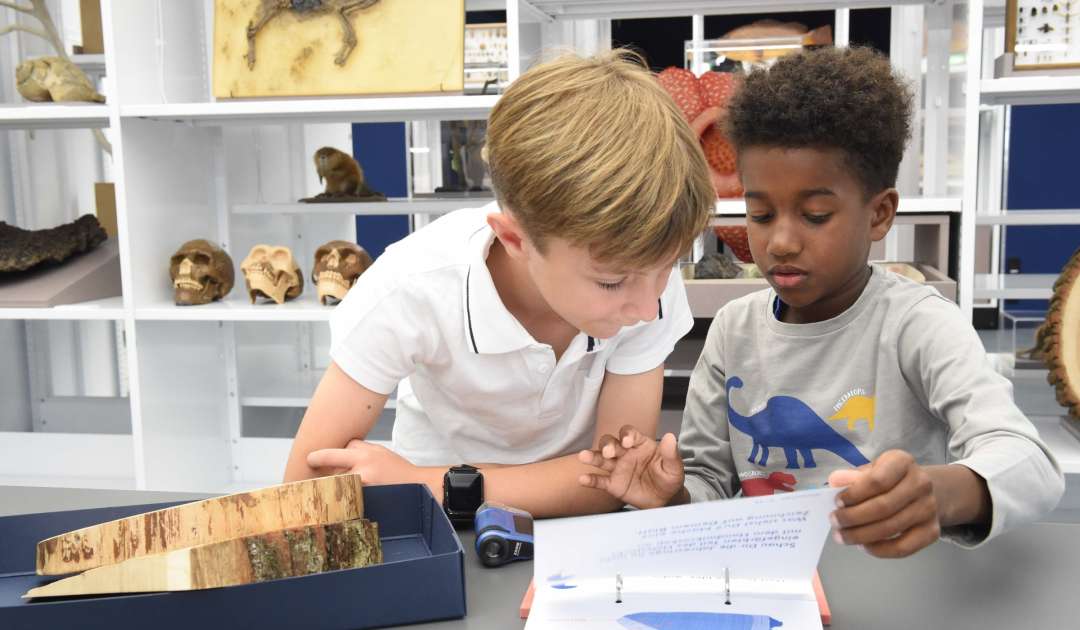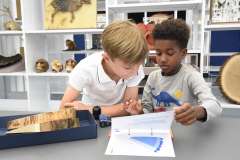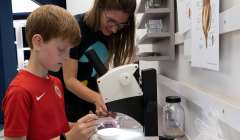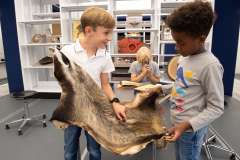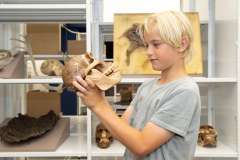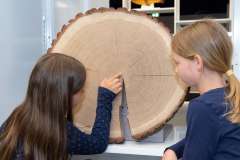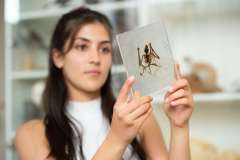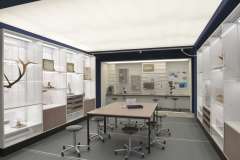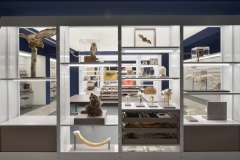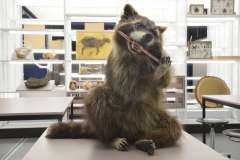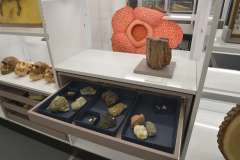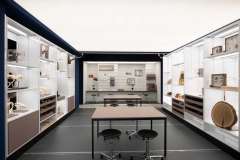Opening of the Aha?! Science Lab
A new hands-on area for research and discovery, starting on June 25, 2022 in the Senckenberg Natural History Museum 25. Juni 2022 im Senckenberg Naturmuseum Frankfurt
Reach into a shark’s mouth, examine a raccoon up close, or look a flea in the eye? That’s possible – starting on June 25 in the “Aha? Science Lab” at the Senckenberg Natural History Museum in Frankfurt! The museum is opening a new space for which the artist collective YRD.works has developed a communicative spatial installation that captures the nature researchers’ collection and workplace atmosphere. Here, adults and children from the age of eight have an opportunity to become active themselves: they can try out scientific methods, get into contact with scientists, work on collection items, and get creative. For example, guided by their own interests, they can measure collection objects, observe them under the microscope and draw them, or observe animal behavior. Facilitators are available for discussion and support. The opening of the “Aha? Science Lab” is another milestone on the way to a participatory and dialogue-based museum.
At the heart of the room is a collection of almost 100 objects put together specifically for the “Aha? Science Lab” collection. This includes the jaws of a tiger shark. “These shark’s teeth alone can tell an involved story,” says Senckenberg Director General Prof. Dr. Klement Tockner. “The habitat of many sharks is threatened by climate change; in addition, many species are at risk of extinction due to hunting, among other factors. When sharks are removed from ecosystems, these can become unbalanced – and just like that, the fascination with a single object brings us to the current twin crises of climate change and biodiversity loss, the central issues of our society,” he continues. “In the ‘Aha? Science Lab,’ we can spark a fascination with nature, allow people to experience it, and communicate how we explore nature and the reasons for doing so,” adds Tockner.
“With the ‘Aha?! Science Lab,’ we have opted for a new and, in the most literal sense of the word, open form of presentation of our topics and for an open form of communication. The research museum is a place of democratic dialogue in which our visitors and we Senckenbergers are actively involved. Here, you can participate in scientific work and engage in a productive exchange,” explains Museum Director Dr. Brigitte Franzen, and she adds: “The collaboration with the artist collective YRD.works was particularly important in this regard, as they contributed their own perspective on the subjects. They created a unique spatial installation with a particularly communicative and flexible atmosphere.
In the “Aha? Science Lab,” visitors can also support science in the form of citizen science projects. At computer workstations, for example, there is an opportunity to work on the “WildLIVE! – Discover Bolivia’s wild animals” project and identify jungle animals in photos. These findings are directly channeled back into the research project, which documents the loss of biodiversity in the Bolivian rainforest, thereby aiming to raise awareness for our treatment of nature. Or you can help prepare sand samples for scientific research. Tiny snails, clams and the like are sorted here using a pair of tweezers. Senckenberg scientists can later use this valuable preparatory work to investigate various questions. For example, the thickness of the animals’ shells or the species composition can be used to draw conclusions about the acidification of the oceans or the change in ocean temperatures.
“It is particularly important to us that our visitors use the ‘Aha? Science Lab’ guided by their own interests and impulses,” says curator Dr. Eva Roßmanith. “We are there to mediate, to provide food for thought and suggest questions, if desired, but above all we want to offer a space and opportunity for ‘learning through discovery,’” she continues.
Research boxes filled with tree discs, feathers, or shark teeth, along with the accompanying questions, encourage students to understand connections in nature and develop their own ideas. Those who want to work creatively can draw, model, or design with natural materials. Themed alcoves allow you to explore the fascinating shapes of single-celled organisms from the deep sea or the diversity of insects, and under the microscope, structures of the smallest organisms become visible.
“Here, objects can be touched and discovered freely, using multiple senses – for example, a specially prepared raccoon or a giant tree disc,” adds co-curator Tuğba Kalkan, and she continues, “A great fascination emanates from each and every one of our objects.”
The opening of the “Aha? Science Lab” represents a starting point for the future of outreach and museum work. The offers are deliberately designed to be experimental. Through direct work with visitors and their feedback, concepts can be developed further, and new projects added. The space is designed precisely with this in mind: It is highly flexible and can easily be adapted to new topics.
On opening day, the “Aha? Science Lab” will also extend into adjacent museum rooms: from 10 am to 4 pm, visitors can talk to experts at stations throughout the museum – and in the process dive into the depths of the oceans, discover the crawling diversity of insects, explore the climate, and test their knowledge of animal tracks.
The “Aha? Science Lab” will be supervised throughout by science educators. In addition, researchers and curators will regularly report on their work and projects on site and be available to answer visitors’ questions.
The lab is a permanent part of the museum and, as of June 25, 2022, will be open at the following times: Tue and Thu 1-5 pm, Wed 10 am-6 pm, Fri / Sat / Sun 10 am-5 pm. The room will be closed on Mondays.
Our thanks go to the “Polytechnische Gesellschaft Frankfurt am Main” foundation and additional sponsors who support the “Aha?! Science Lab.”
